Remote Sensing Estimation of CDOM for Songhua River of China: Distributions and Implications
Abstract
1. Introduction
2. Methods and Materials
2.1. Study Area
2.2. Field Sampling and Laboratory Measurements
2.3. Model Calibration and Validation
2.4. Other Datasets
2.5. Statistical Analysis
3. Results
3.1. In Situ Measurement of CDOM and DOC in Songhua River
3.2. Model Calibration and Validation of CDOM and DOC
3.3. The Spatial and Temporal Distribution of CDOM in Songhua River
3.4. The Factors Contributed to CDOM of Songhua River
4. Discussion
4.1. Advantages and Disadvantages of the Model
4.2. The Influencing Factors of CDOM Changes in the Songhua River
4.3. Seasonal Analysis of DOC Flux in the Songhua River
5. Conclusions
Author Contributions
Funding
Data Availability Statement
Acknowledgments
Conflicts of Interest
References
- Gao, Y.; Jia, J.; Lu, Y.; Sun, K.; Wang, J.; Wang, S. Carbon transportation, transformation, and sedimentation processes at the land-river-estuary continuum. Fundam. Res. 2022, 159, 3–30. [Google Scholar] [CrossRef]
- Sharma, D. Role of Rivers in the Carbon Cycle and the Impact of Anthropogenic Activities. In Rivers of India: Past, Present and Future; Springer: Berlin/Heidelberg, Germany, 2024; pp. 173–196. [Google Scholar]
- Wagner, S.; Schubotz, F.; Kaiser, K.; Hallmann, C.; Waska, H.; Rossel, P.E.; Hansman, R.; Elvert, M.; Middelburg, J.J.; Engel, A.; et al. Soothsaying DOM: A current perspective on the future of oceanic dissolved organic carbon. Front. Mar. Sci. 2020, 7, 341. [Google Scholar] [CrossRef]
- Zhang, Y.; Zhou, L.; Zhou, Y.; Zhang, L.; Yao, X.; Shi, K.; Jeppesen, E.; Yu, Q.; Zhu, W. Chromophoric dissolved organic matter in inland waters: Present knowledge and future challenges. Sci. Total Environ. 2021, 759, 143550. [Google Scholar] [CrossRef] [PubMed]
- Wen, Z.; Song, K.; Liu, G.; Lyu, L.; Shang, Y.; Fang, C.; Du, J. Characterizing DOC sources in China’s Haihe River basin using spectroscopy and stable carbon isotopes. Environ. Pollut. 2020, 258, 113684. [Google Scholar] [CrossRef]
- Zhang, X.Y.; Chen, X.; Deng, H.; Du, Y.; Jin, H.Y. Absorption features of chromophoric dissolved organic matter (CDOM) and tracing implication for dissolved organic carbon (DOC) in Changjiang Estuary, China. Biogeosciences Discuss. 2013, 10, 12217–12250. [Google Scholar]
- Bai, Y.; Cui, Z.; Ding, D.; Hong, C.; Cui, H.; Hu, Q.; Zhou, M.; Qu, K. The characteristics of CDOM structural composition and the effect on indirect photodegradation of sulfamerazine. Sci. Total Environ. 2023, 888, 164231. [Google Scholar] [CrossRef]
- Li, D.; Pan, B.; Zheng, X.; Jiang, X.; Zhao, G.; Han, X. CDOM in the source regions of the Yangtze and Yellow Rivers, China: Optical properties, possible sources, and their relationships with environmental variables. Environ. Sci. Pollut. Res. 2020, 27, 32856–32873. [Google Scholar] [CrossRef]
- Wang, Y.; Zhang, D.; Shen, Z.; Chen, J.; Feng, C. Characterization and spacial distribution variability of chromophoric dissolved organic matter (CDOM) in the Yangtze Estuary. Chemosphere 2014, 95, 353–362. [Google Scholar] [CrossRef]
- Zhuang, D.; Shao, T.; Zheng, K. Characteristics, sources and driving factors of riverine CDOM in a severe erosion basin on the Loess Plateau, China. Ecol. Indic. 2023, 148, 110080. [Google Scholar] [CrossRef]
- Shi, Y.; Zhang, L.; Li, Y.; Zhou, L.; Zhou, Y.; Zhang, Y.; Huang, C.; Li, H.; Zhu, G. Influence of land use and rainfall on the optical properties of dissolved organic matter in a key drinking water reservoir in China. Sci. Total Environ. 2020, 699, 134301. [Google Scholar] [CrossRef]
- Zheng, K.; Shao, T.; Ning, J.; Zhuang, D.; Liang, X. Water quality, basin characteristics, and discharge greatly affect CDOM in highly turbid rivers in the Yellow River Basin, China. J. Clean. Prod. 2023, 404, 136995. [Google Scholar] [CrossRef]
- Wen, Y.; Xiao, M.; Chen, Z.; Zhang, W.; Yue, F. Seasonal variations of dissolved organic matter in urban rivers of Northern China. Land 2023, 12, 273. [Google Scholar] [CrossRef]
- Fichot, C.G.; Tzortziou, M.; Mannino, A. Remote sensing of dissolved organic carbon (DOC) stocks, fluxes and transformations along the land-ocean aquatic continuum: Advances, challenges, and opportunities. Earth-Sci. Rev. 2023, 242, 104446. [Google Scholar] [CrossRef]
- Battin, T.J.; Luyssaert, S.; Kaplan, L.A.; Aufdenkampe, A.K.; Richter, A.; Tranvik, L.J. The boundless carbon cycle. Nat. Geosci. 2009, 2, 598–600. [Google Scholar] [CrossRef]
- Zhang, L.; Xu, Y.J.; Li, S. Riverine dissolved organic matter (DOM) as affected by urbanization gradient. Environ. Res. 2022, 212, 113457. [Google Scholar] [CrossRef] [PubMed]
- Tzortziou, M.; Zeri, C.; Dimitriou, E.; Ding, Y.; Jaffé, R.; Anagnostou, E.; Pitta, E.; Mentzafou, A. Colored dissolved organic matter dynamics and anthropogenic influences in a major transboundary river and its coastal wetland. Limnol. Oceanogr. 2015, 60, 1222–1240. [Google Scholar] [CrossRef]
- Chen, J.; Chen, S.; Fu, R.; Li, D.; Jiang, H.; Wang, C.; Peng, Y.; Jia, K.; Hicks, B.J. Remote sensing big data for water environment monitoring: Current status, challenges, and future prospects. Earth’s Future 2022, 10, e2021EF002289. [Google Scholar] [CrossRef]
- Kong, X.; Liu, Y.; Jian, H.; Su, R.; Yao, Q.; Shi, X. New approach for rapid assessment of trophic status of Yellow Sea and East China Sea using easy-to-measure parameters. J. Ocean Univ. China 2017, 16, 781–792. [Google Scholar] [CrossRef]
- Liu, G.; Li, S.; Song, K.; Wang, X.; Wen, Z.; Kutser, T.; Andrew Jacinthe, P.; Shang, Y.; Lyu, Y.; Fang, C.; et al. Remote sensing of CDOM and DOC in alpine lakes across the Qinghai-Tibet Plateau using Sentinel-2A imagery data. J. Environ. Manag. 2021, 286, 112231. [Google Scholar] [CrossRef]
- Ayad, M.; Li, J.; Holt, B.; Lee, C. Analysis and classification of stormwater and wastewater runoff from the Tijuana River using remote sensing imagery. Front. Environ. Sci. 2020, 8, 599030. [Google Scholar] [CrossRef]
- Wang, Y.; Wang, P.; Bai, Y.; Tian, Z.; Li, J.; Shao, X.; Mustavich, L.F.; Li, B. Assessment of surface water quality via multivariate statistical techniques: A case study of the Songhua River Harbin region, China. J. Hydro-Environ. Res. 2013, 7, 30–40. [Google Scholar] [CrossRef]
- Ma, M.; Liu, S.; Su, M.; Wang, C.; Ying, Z.; Huo, M.; Lin, Y.; Yang, W. Spatial distribution and potential sources of microplastics in the Songhua River flowing through urban centers in Northeast China. Environ. Pollut. 2022, 292, 118384. [Google Scholar] [CrossRef] [PubMed]
- Li, F.; Zhang, G.; Xu, Y.J. Assessing climate change impacts on water resources in the Songhua River basin. Water 2016, 8, 420. [Google Scholar] [CrossRef]
- Miao, C.; Yang, L.; Liu, B.; Gao, Y.; Li, S. Streamflow changes and its influencing factors in the mainstream of the Songhua River basin, Northeast China over the past 50 years. Environ. Earth Sci. 2011, 63, 489–499. [Google Scholar] [CrossRef]
- Yang, S.; Bai, Y.; Alatalo, J.M.; Wang, H.; Tong, J.; Liu, G.; Zhang, F.; Chen, J. Spatial–temporal pattern of cultivated land productivity based on net primary productivity and analysis of influencing factors in the Songhua River basin. Land Degrad. Dev. 2022, 33, 1917–1932. [Google Scholar] [CrossRef]
- Wang, H.; Li, C.; Yan, G.; Zhang, Y.; Wang, H.; Dong, W.; Chu, Z.; Chang, Y.; Ling, Y. Seasonal distribution characteristics and ecological risk assessment of phthalate esters in surface sediment of Songhua River basin. Environ. Pollut. 2023, 337, 122567. [Google Scholar] [CrossRef] [PubMed]
- Markager, S.; Vincent, W.F. Spectral light attenuation and the absorption of UV and blue light in natural waters. Limnol. Oceanogr. 2000, 45, 642–650. [Google Scholar] [CrossRef]
- Tao, P.; Jin, M.; Yu, X.; Yu, J.; Zheng, R. Spatiotemporal variations in chromophoric dissolved organic matter (CDOM) in a mixed land-use river: Implications for surface water restoration. J. Environ. Manag. 2021, 277, 111498. [Google Scholar] [CrossRef]
- Main-Knorn, M.; Pflug, B.; Louis, J.; Debaecker, V.; Müller-Wilm, U.; Gascon, F. Sen2Cor for Sentinel-2. In Proceedings of the Image and Signal Processing for Remote Sensing XXIII, Warsaw, Poland, 4 October 2017; p. 3. [Google Scholar]
- Friedman, J.H. Greedy function approximation: A gradient boosting machine. Annals of Statistics. 2001, 29(5), 1189–1232. [Google Scholar] [CrossRef]
- Chen, T.; Guestrin, C. Xgboost: A scalable tree boosting system. In Proceedings of the 22nd ACM SIGKDD International Conference on Knowledge Discovery and Data Mining, San Francisco, CA, USA, 13–17 August 2016; pp. 785–794. [Google Scholar] [CrossRef]
- Drucker, H.; Burges, C.J.; Kaufman, L.; Smola, A.; Vapnik, V. Support vector regression machines. Adv. Neural Inf. Process. Syst. 1996, 9, 155–161. [Google Scholar]
- Rumelhart, D.E.; Hinton, G.E.; Williams, R.J. Learning representations by back-propagating errors. Nature 1986, 323, 533–536. [Google Scholar] [CrossRef]
- Breiman, L. Random forests. Mach. Learn. 2001, 45, 5–32. [Google Scholar] [CrossRef]
- Yang, J.; Huang, X. 30 m annual land cover and its dynamics in China from 1990 to 2019. Earth Syst. Sci. Data Discuss. 2021, 2021, 1–29. [Google Scholar]
- Peng, S.Z. 1-km Monthly Precipitation Dataset for China (1901–2022); National Tibetan Plateau Data Center: Beijing, China, 2020. [Google Scholar] [CrossRef]
- Bentéjac, C.; Csörgő, A.; Martínez-Muñoz, G. A comparative analysis of gradient boosting algorithms. Artif. Intell. Rev. 2021, 54, 1937–1967. [Google Scholar] [CrossRef]
- Ling, Z.; Sun, D.; Wang, S.; Qiu, Z.; Huan, Y.; Mao, Z.; He, Y. Remote sensing estimation of colored dissolved organic matter (CDOM) from GOCI measurements in the Bohai Sea and Yellow Sea. Environ. Sci. Pollut. Res. 2020, 27, 6872–6885. [Google Scholar] [CrossRef]
- Li, J.; Yu, Q.; Tian, Y.Q.; Boutt, D.F. Effects of landcover, soil property, and temperature on covariations of DOC and CDOM in inland waters. J. Geophys. Res. Biogeosciences 2018, 123, 1352–1365. [Google Scholar] [CrossRef]
- Song, K.; Zhao, Y.; Wen, Z.; Fang, C.; Shang, Y. A systematic examination of the relationships between CDOM and DOC in inland waters in China. Hydrol. Earth Syst. Sci. 2017, 21, 5127–5141. [Google Scholar] [CrossRef]
- Alcântara, E.; Bernardo, N.; Rodrigues, T.; Watanabe, F. Modeling the spatio-temporal dissolved organic carbon concentration in Barra Bonita reservoir using OLI/Landsat-8 images. Model. Earth Syst. Environ. 2017, 3, 1–6. [Google Scholar] [CrossRef]
- Shang, Y.; Song, K.; Wen, Z.; Lyu, L.; Zhao, Y.; Fang, C.; Zhang, B. Characterization of CDOM absorption of reservoirs with its linkage of regions and ages across China. Environ. Sci. Pollut. Res. 2018, 25, 16009–16023. [Google Scholar] [CrossRef]
- Churilova, T.; Moiseeva, N.; Skorokhod, E.; Efimova, T.; Buchelnikov, A.; Artemiev, V.; Salyuk, P. Parameterization of Light Absorption of Phytoplankton, Non-Algal Particles and Coloured Dissolved Organic Matter in the Atlantic Region of the Southern Ocean (Austral Summer of 2020). Remote Sens. 2023, 15, 634. [Google Scholar] [CrossRef]
- Santiago, M.I.; Frey, K.E. Assessment of empirical and semi-analytical algorithms using MODIS-aqua for representing in-situ chromophoric dissolved organic matter (CDOM) in the bering, chukchi, and Western Beaufort seas of the Pacific Arctic region. Remote Sens. 2021, 13, 3673. [Google Scholar] [CrossRef]
- Lee, C.S.; Han, K.-S. Comparison of Two Semi-Empirical BRDF algorithms using SPOT/VGT. Korean J. Remote Sens. 2013, 29, 307–314. [Google Scholar] [CrossRef][Green Version]
- Betancur-Turizo, S.P.; González-Silvera, A.; Santamaría-del-Ángel, E.; Tan, J.; Frouin, R. Evaluation of Semi-Analytical Algorithms to Retrieve Particulate and Dissolved Absorption Coefficients in Gulf of California Optically Complex Waters. Remote Sens. 2018, 10, 1443. [Google Scholar] [CrossRef]
- Li, K.; Cui, S.; Zhang, F.; Hough, R.; Fu, Q.; Zhang, Z.; Gao, S.; An, L. Concentrations, possible sources and health risk of heavy metals in multi-media environment of the Songhua River, China. Int. J. Environ. Res. Public Health 2020, 17, 1766. [Google Scholar] [CrossRef]
- Coelho, C.; Heim, B.; Foerster, S.; Brosinsky, A.; De Araújo, J.C. In situ and satellite observation of CDOM and chlorophyll-a dynamics in small water surface reservoirs in the brazilian semiarid region. Water 2017, 9, 913. [Google Scholar] [CrossRef]
- Zhang, L.; Meng, F.; Liu, N.; Zhang, J.; Xue, H. The Taxon-Specific Species Sensitivity and Aquatic Ecological Risk Assessment of Three Heavy Metals in Songhua River Water, China. Water 2023, 15, 3694. [Google Scholar] [CrossRef]
- Shang, Y.; Song, K.; Jacinthe, P.A.; Wen, Z.; Zhao, Y.; Lyu, L.; Fang, C.; Li, S.; Liu, G.; Zhang, N. Fluorescence spectroscopy of CDOM in urbanized waters across gradients of development/industrialization of China. J. Hazard. Mater. 2021, 415, 125630. [Google Scholar] [CrossRef]
- Finlay, J.; Neff, J.; Zimov, S.; Davydova, A.; Davydov, S. Snowmelt dominance of dissolved organic carbon in high-latitude watersheds: Implications for characterization and flux of river DOC. Geophys. Res. Lett. 2006, 33, 10. [Google Scholar] [CrossRef]
- Kozak, C.; Fernandes, C.V.S.; Braga, S.M.; do Prado, L.L.; Froehner, S.; Hilgert, S. Water quality dynamic during rainfall episodes: Integrated approach to assess diffuse pollution using automatic sampling. Environ. Monit. Assess. 2019, 191, 1–13. [Google Scholar] [CrossRef]
- Tiwari, T.; Sponseller, R.A.; Laudon, H. Extreme climate effects on dissolved organic carbon concentrations during snowmelt. J. Geophys. Res. Biogeosciences 2018, 123, 1277–1288. [Google Scholar] [CrossRef]
- Ghosal, D.; Ghosh, S.; Dutta, T.K.; Ahn, Y. Current state of knowledge in microbial degradation of polycyclic aromatic hydrocarbons (PAHs): A review. Front. Microbiol. 2016, 7, 1369. [Google Scholar] [CrossRef] [PubMed]
- Yang, Y.; Zhao, Z.; Chang, Y.; Wang, H.; Wang, H.; Dong, W.; Yan, G. PAHs and PAEs in the surface sediments from Nenjiang River and the Second Songhua River, China: Distribution, composition and risk assessment. Process Saf. Environ. Prot. 2023, 178, 765–775. [Google Scholar] [CrossRef]
- Liu, D.; Bai, Y.; He, X.; Tao, B.; Pan, D.; Chen, C.T.A.; Gong, C. Satellite estimation of particulate organic carbon flux from Changjiang River to the estuary. Remote Sens. Environ. 2019, 223, 307–319. [Google Scholar] [CrossRef]
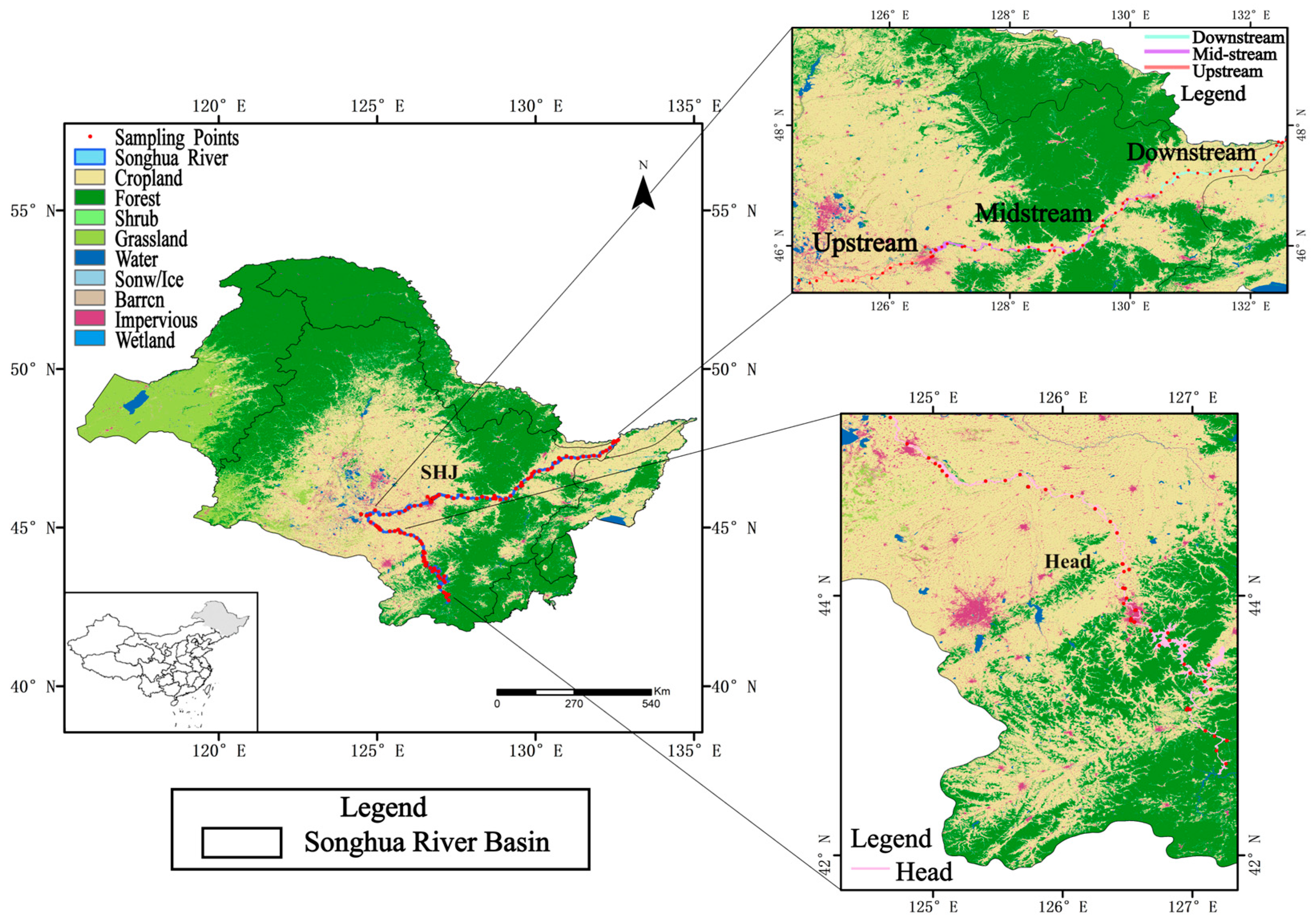
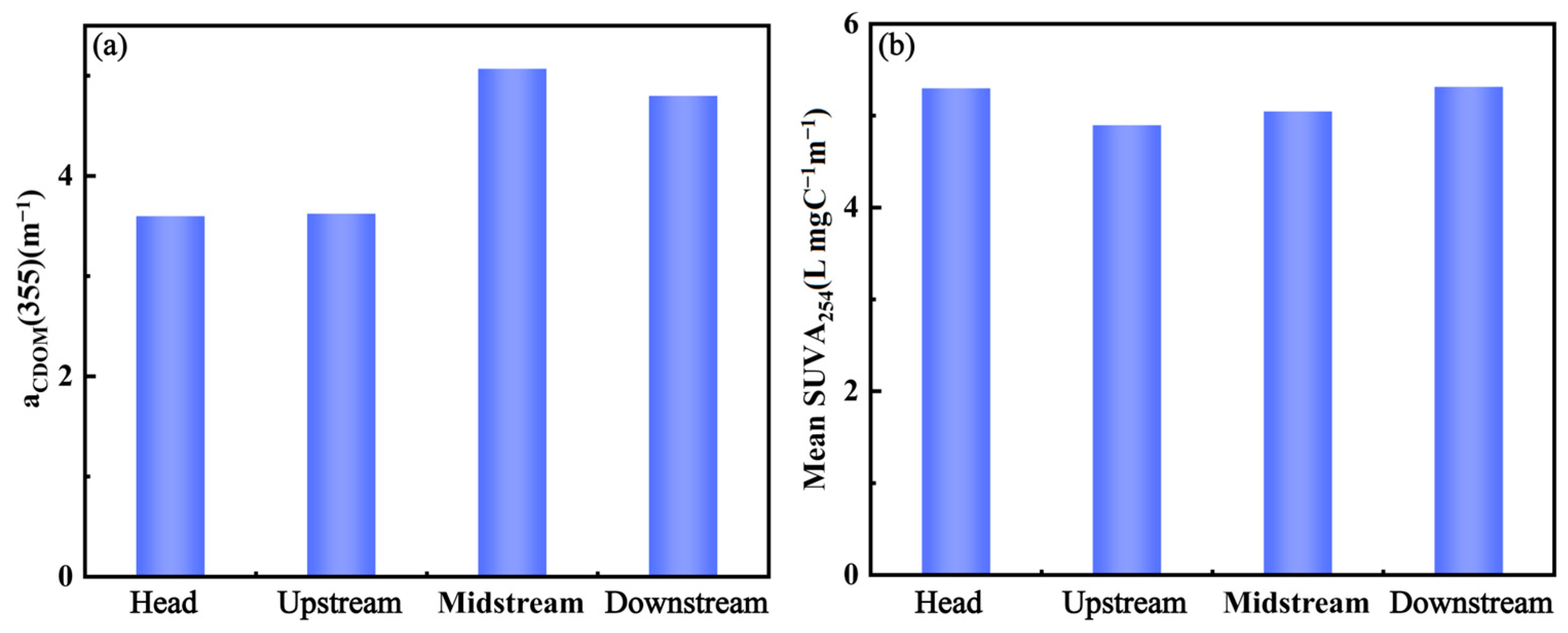
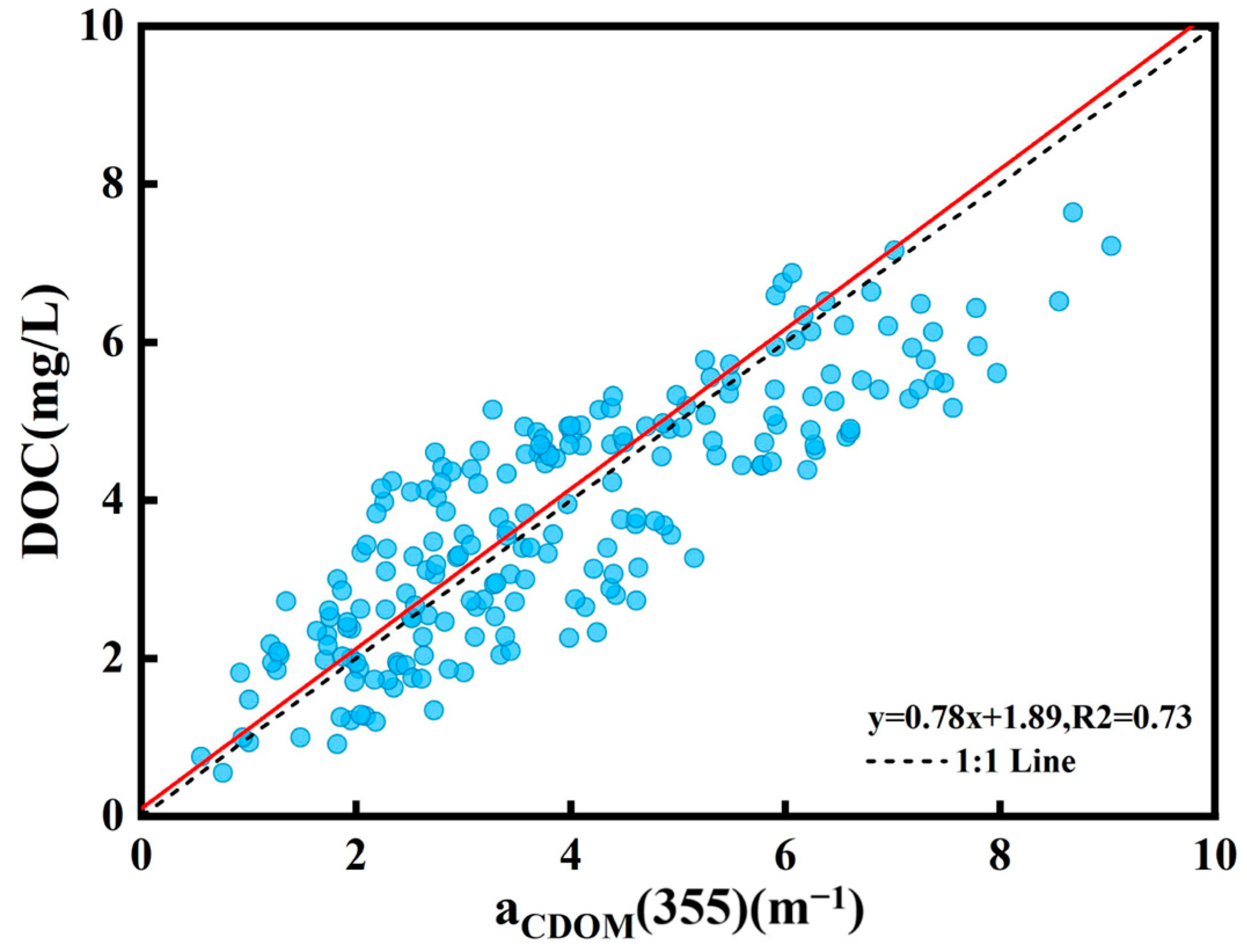

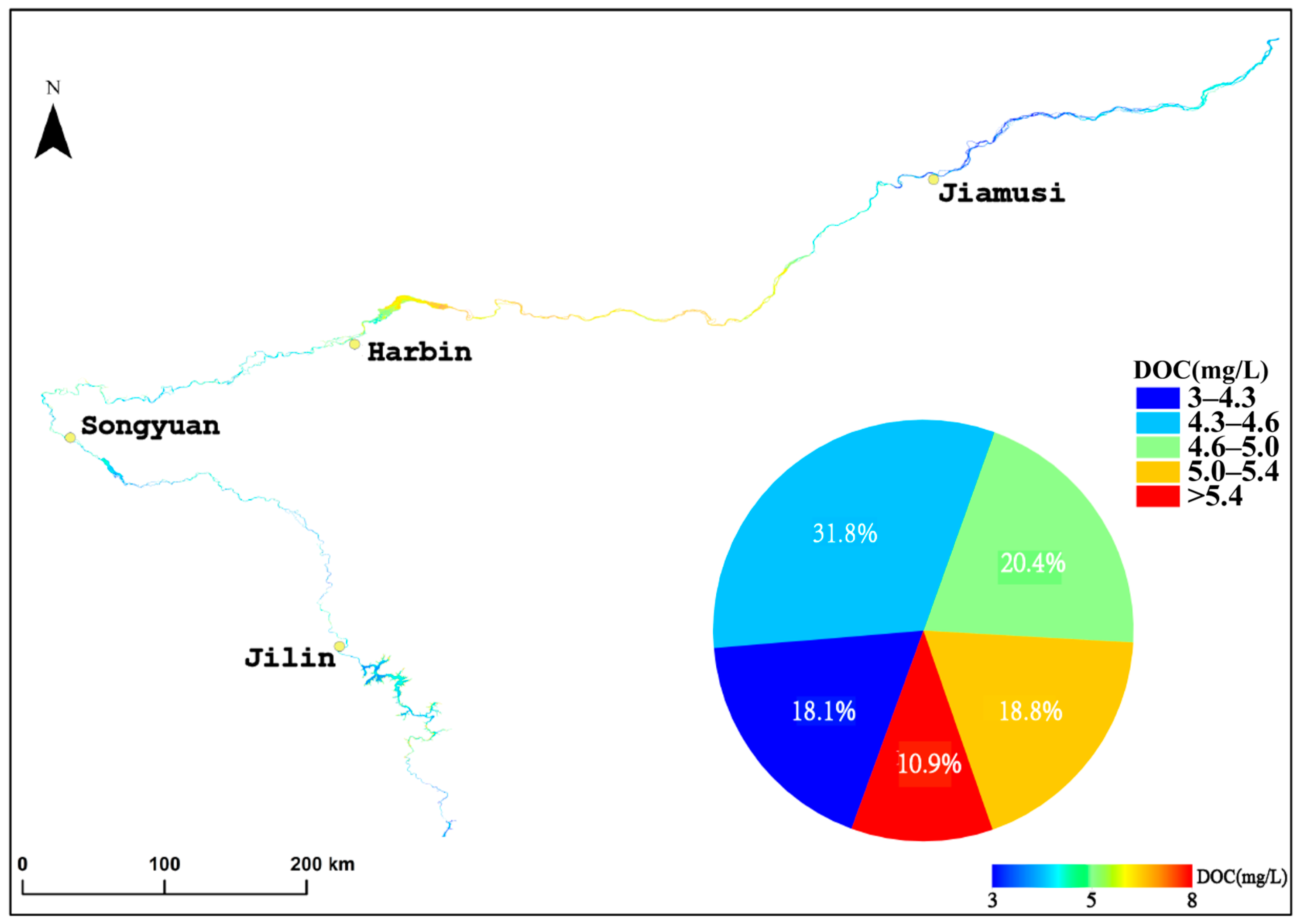
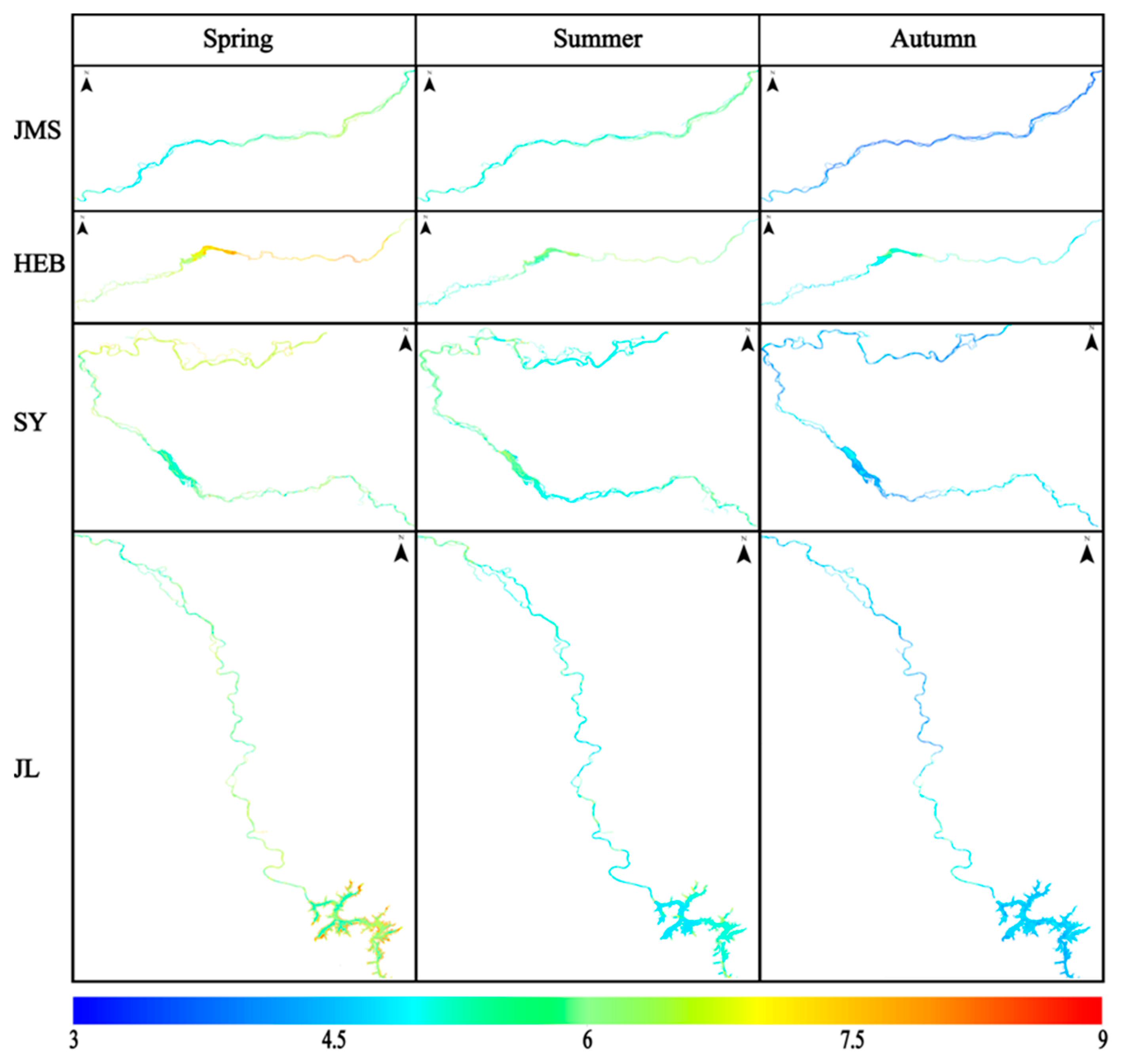
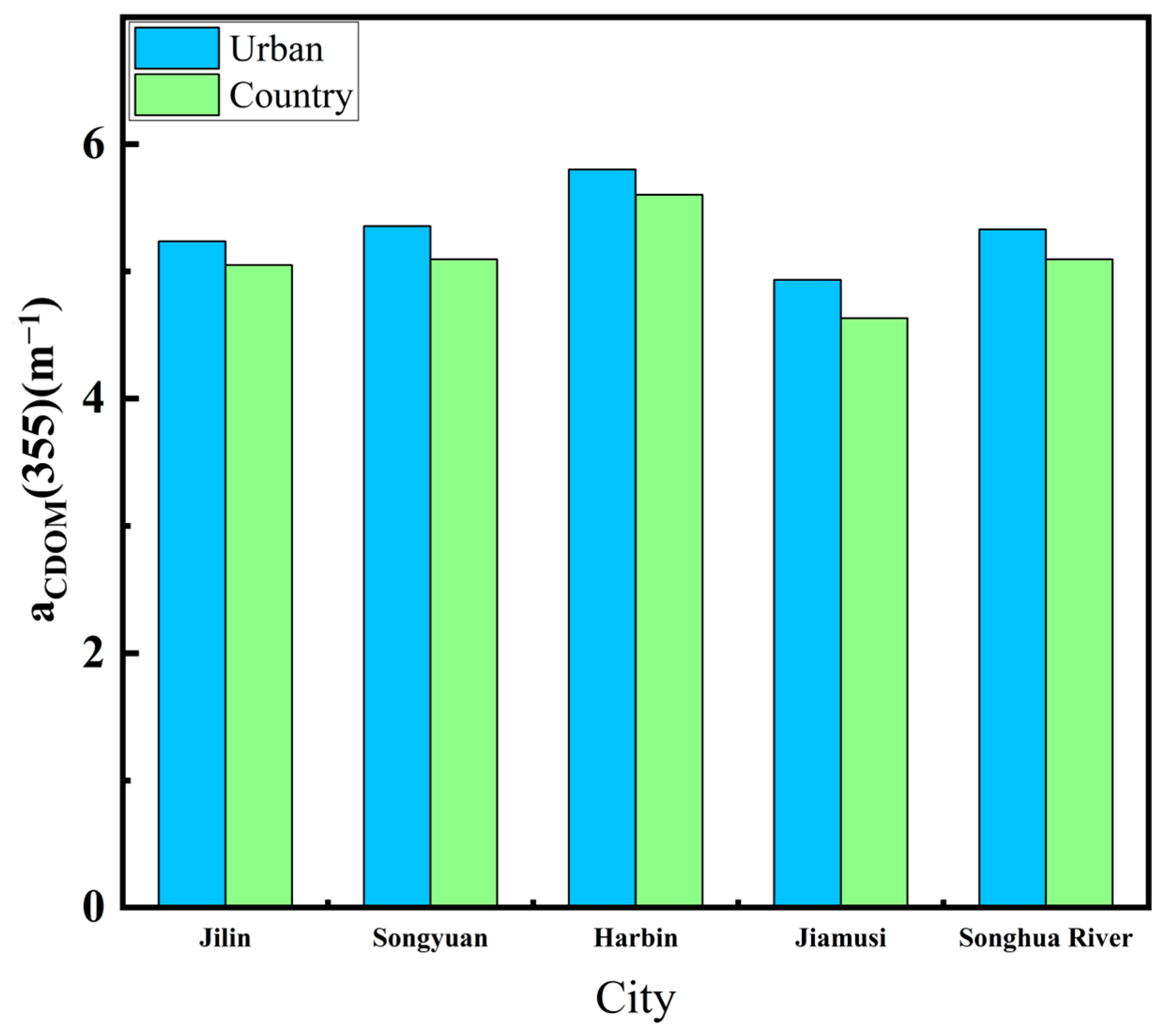
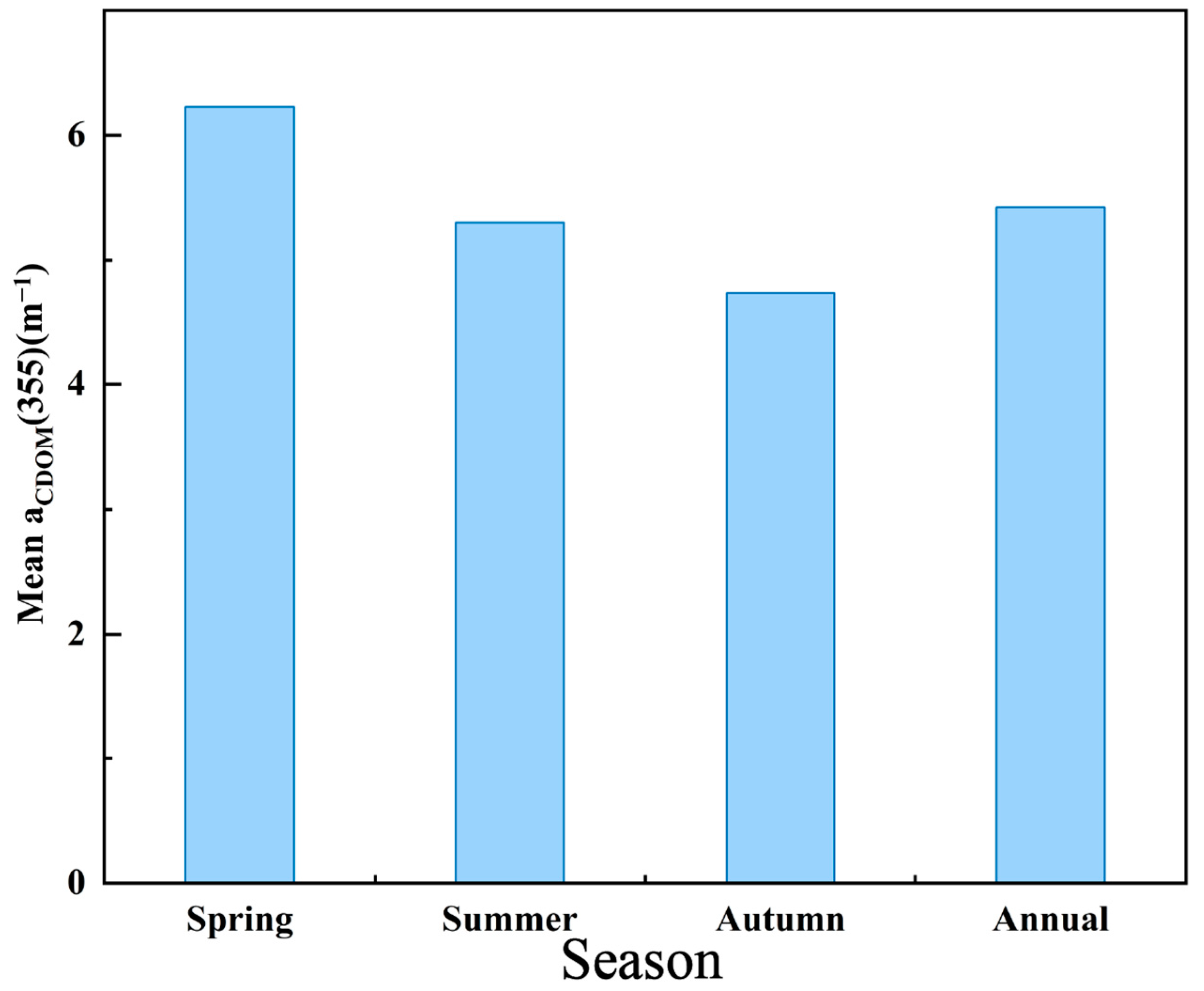
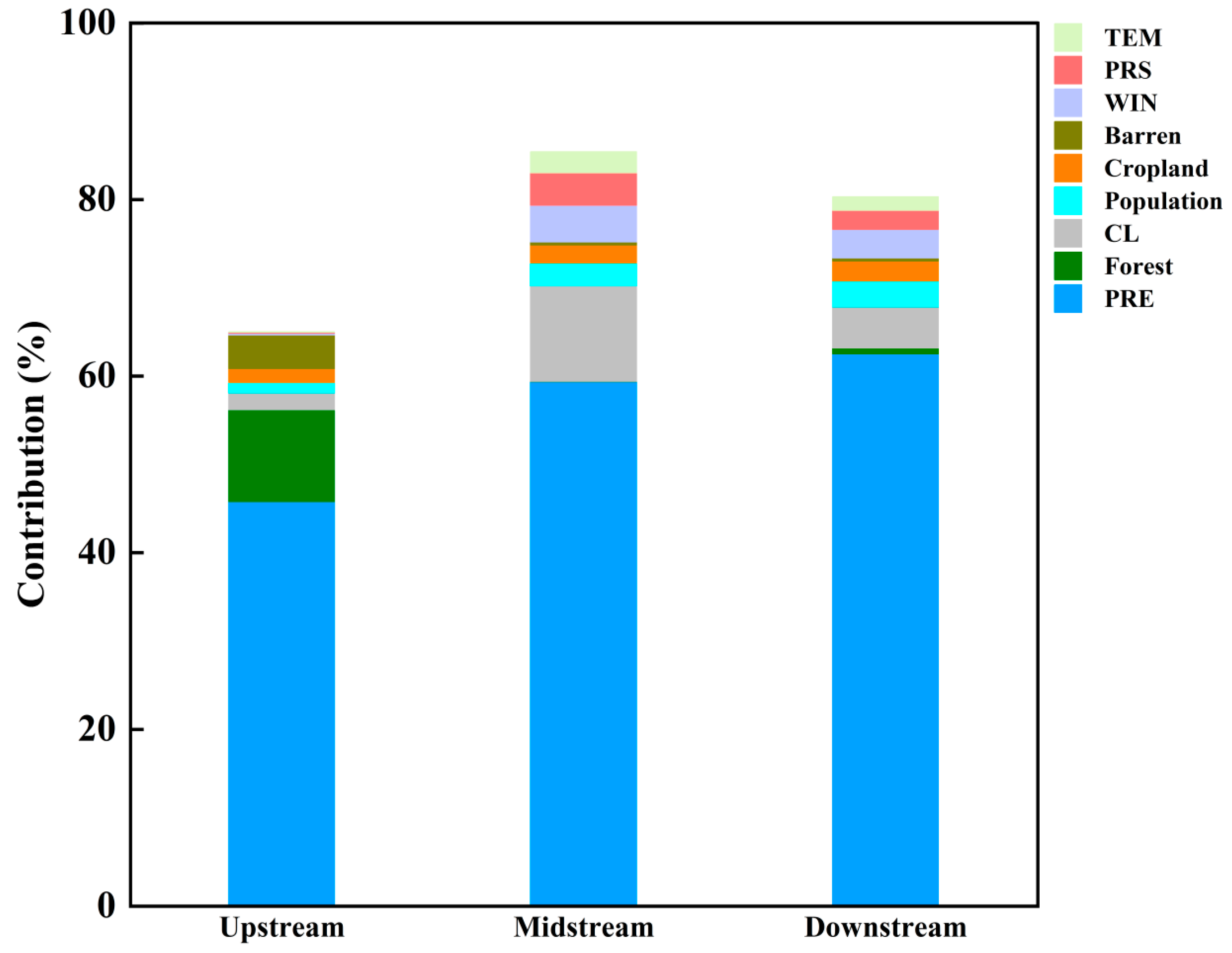
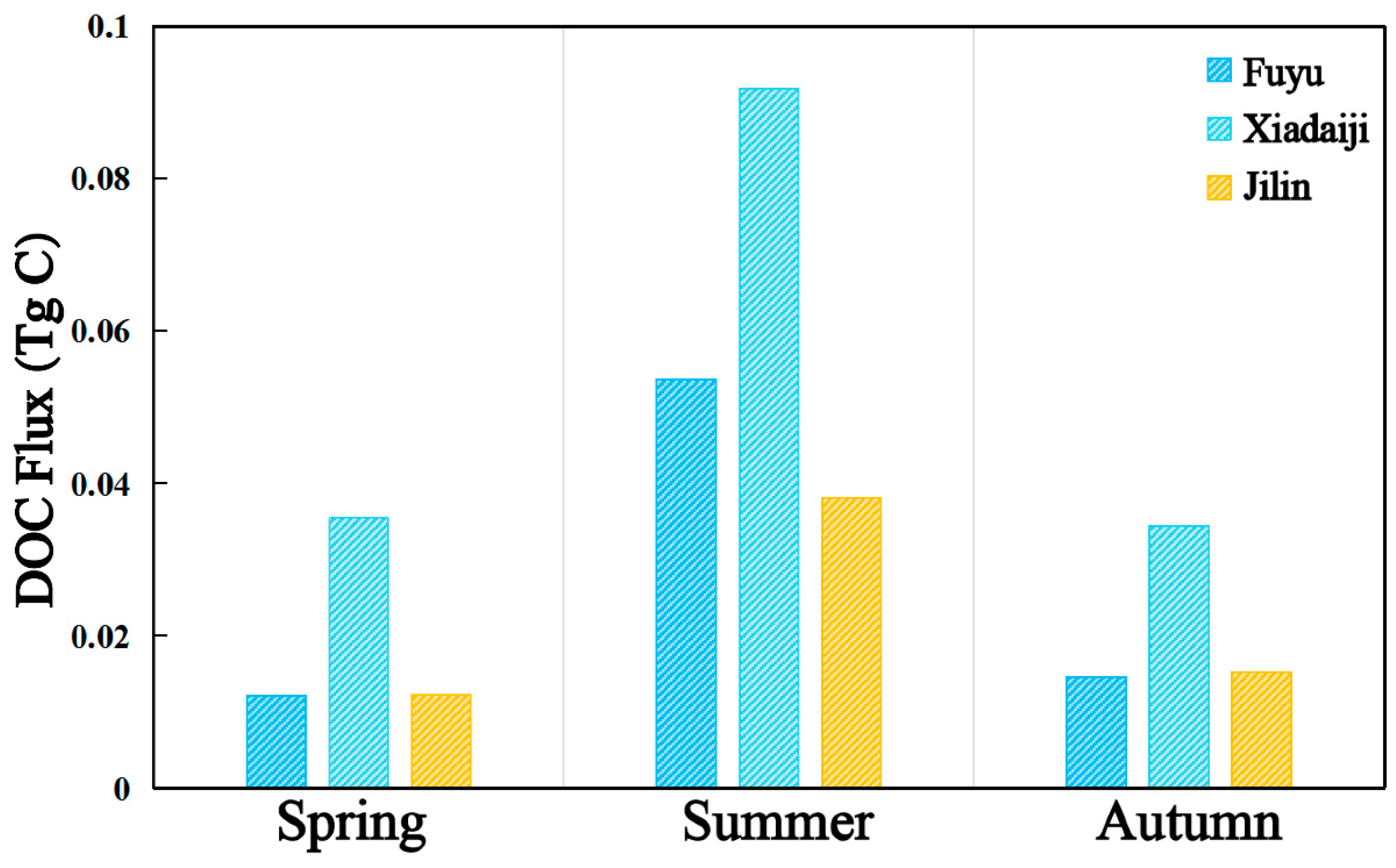
| Linear Model | R2 for Calibration | R2 for Validation |
|---|---|---|
| 70.84B2 + 1.12 | 0.54 | 0.44 |
| 52.72B3 + 1.03 | 0.43 | 0.29 |
| 34.32B4 + 2.34 | 0.37 | 0.34 |
| 507B2 × B3 + 2.72 | 0.51 | 0.39 |
| 152.26(B1 × B2)/((B3 + B2) + (B4 × B1)) + 0.98 | 0.74 | 0.68 |
| ML Algorithms | R2 of Calibration | R2 for Validation | Calibration RMSE (m−1) | Validation RMSE (m−1) |
|---|---|---|---|---|
| BP | 0.65 | 0.53 | 1.13 | 1.40 |
| GBDT | 0.94 | 0.71 | 0.44 | 1.00 |
| RF | 0.82 | 0.73 | 0.8 | 0.95 |
| SVR | 0.69 | 0.60 | 1.10 | 1.40 |
| XGBoost | 0.89 | 0.85 | 0.62 | 0.71 |
| Contributing (%) | PRE | Forest | CL | Population | Cropland | Barren | WIN | PRS |
|---|---|---|---|---|---|---|---|---|
| Upstream | 45.77 | 10.41 | 1.93 | 1.17 | 1.55 | 3.81 | 0.20 | 0.13 |
| Midstream | 59.38 | 0.003 | 10.85 | 2.59 | 2.03 | 0.36 | 4.16 | 3.66 |
| Downstream | 62.53 | 0.66 | 4.65 | 2.95 | 2.24 | 0.35 | 3.26 | 2.16 |
Disclaimer/Publisher’s Note: The statements, opinions and data contained in all publications are solely those of the individual author(s) and contributor(s) and not of MDPI and/or the editor(s). MDPI and/or the editor(s) disclaim responsibility for any injury to people or property resulting from any ideas, methods, instructions or products referred to in the content. |
© 2024 by the authors. Licensee MDPI, Basel, Switzerland. This article is an open access article distributed under the terms and conditions of the Creative Commons Attribution (CC BY) license (https://creativecommons.org/licenses/by/4.0/).
Share and Cite
Feng, P.; Song, K.; Wen, Z.; Tao, H.; Yu, X.; Shang, Y. Remote Sensing Estimation of CDOM for Songhua River of China: Distributions and Implications. Remote Sens. 2024, 16, 4608. https://doi.org/10.3390/rs16234608
Feng P, Song K, Wen Z, Tao H, Yu X, Shang Y. Remote Sensing Estimation of CDOM for Songhua River of China: Distributions and Implications. Remote Sensing. 2024; 16(23):4608. https://doi.org/10.3390/rs16234608
Chicago/Turabian StyleFeng, Pengju, Kaishan Song, Zhidan Wen, Hui Tao, Xiangfei Yu, and Yingxin Shang. 2024. "Remote Sensing Estimation of CDOM for Songhua River of China: Distributions and Implications" Remote Sensing 16, no. 23: 4608. https://doi.org/10.3390/rs16234608
APA StyleFeng, P., Song, K., Wen, Z., Tao, H., Yu, X., & Shang, Y. (2024). Remote Sensing Estimation of CDOM for Songhua River of China: Distributions and Implications. Remote Sensing, 16(23), 4608. https://doi.org/10.3390/rs16234608









